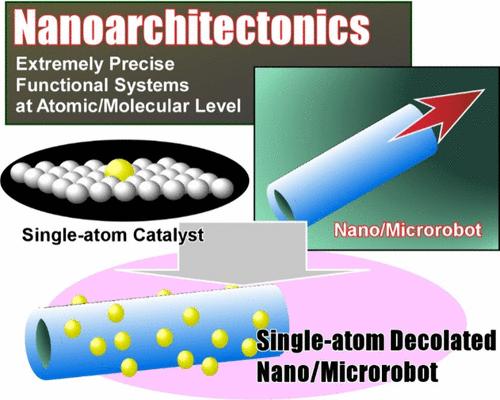机器人及其他功能的单原子纳米结构
IF 7.3
1区 化学
Q1 CHEMISTRY, MULTIDISCIPLINARY
引用次数: 0
摘要
对于一个可持续发展的社会,材料的发展必须以长期保持良好的经济活动为目标,而不破坏全球环境或过度使用资源。因此,对先进和敏感材料的开发需求日益增加。很明显,纳米尺度上的结构控制对于高效和高选择性的功能表达尤为重要。这可以通过一种新兴的纳米建筑学方法来实现,纳米建筑学是将单个原子、分子及其团簇构建成纳米材料的概念。这一研究路线的最终目标之一是在原子和分子水平上构建极其精确的功能动态系统。从这个角度来看,单原子催化剂可以被认为是实现这一目标的活性组分。本展望讨论了在纳米/微型机器人领域实现单原子催化剂作为活性组分的功能系统。单原子修饰纳米/微机器人是利用单原子催化活性的动态系统;它们可以用来增强推进能力或提供催化能力。本展望包括三个主要部分:(i)对单原子催化剂和其他催化剂的综述;(ii)单原子装饰纳米/微型机器人;(iii)单原子纳米结构的其他功能。最后,对单原子修饰纳米/微机器人的未来发展方向进行了展望。特别是,预计将利用人工智能开发下一代智能单原子装饰纳米/微型机器人。基本故事、主要故事和次要故事的结合将影响单原子纳米结构在机器人和其他功能研究领域的多样性和未来潜力。本文章由计算机程序翻译,如有差异,请以英文原文为准。

Single-Atom Nanoarchitectonics for Robotics and Other Functions
For a sustainable society, the development of materials must be carried out with the aim of maintaining good economic activity in the long term without damaging the global environment or overusing resources. Therefore, there is an increasing need for the development of advanced and sensitive materials. It has become clear that structural control at the nanoscale is particularly important for efficient and highly selective functional expression. This can be achieved with an emerging methodology of nanoarchitectonics, which is the concept of building functional materials from individual atoms, molecules, and their clusters into nanomaterials. One of the ultimate goals of this line of research is to construct extremely precise functional dynamic systems originating at the atomic and molecular levels. From this point of view, single-atom catalysts can be considered as the active components to achieve this goal. This Perspective discusses functional systems that implement single-atom catalysts as active components in the field of nano/microrobotics. Single-atom-decorated nano/microrobots are dynamic systems that exploit the catalytic activity of single atoms; they can be used to enhance propulsion abilities or to provide the catalytic capability. This Perspective consists of three main parts: (i) reviews on single-atom catalysts and others; (ii) single-atom-decorated nano/microrobots; (iii) other functions of single-atom nanoarchitectonics. Finally, the paper concludes with a discussion on the future direction and development of single-atom-decorated nano/microrobots. In particular, it is expected that the next generation of intelligent single-atom-decorated nano/microrobots will be developed using artificial intelligence. The combination of the basic story, the main story, and the side story will affect the diversity and future potential in the research fields of single-atom nanoarchitectonics for robotics and other functions.
求助全文
通过发布文献求助,成功后即可免费获取论文全文。
去求助
来源期刊

ACS Sustainable Chemistry & Engineering
CHEMISTRY, MULTIDISCIPLINARY-ENGINEERING, CHEMICAL
CiteScore
13.80
自引率
4.80%
发文量
1470
审稿时长
1.7 months
期刊介绍:
ACS Sustainable Chemistry & Engineering is a prestigious weekly peer-reviewed scientific journal published by the American Chemical Society. Dedicated to advancing the principles of green chemistry and green engineering, it covers a wide array of research topics including green chemistry, green engineering, biomass, alternative energy, and life cycle assessment.
The journal welcomes submissions in various formats, including Letters, Articles, Features, and Perspectives (Reviews), that address the challenges of sustainability in the chemical enterprise and contribute to the advancement of sustainable practices. Join us in shaping the future of sustainable chemistry and engineering.
 求助内容:
求助内容: 应助结果提醒方式:
应助结果提醒方式:


